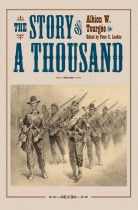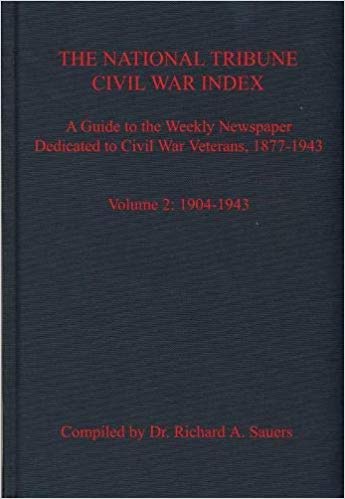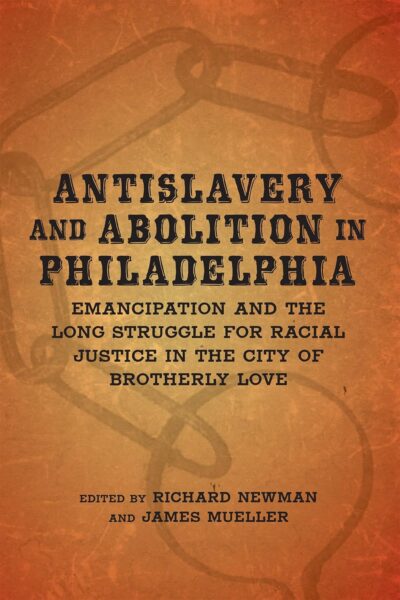The Story of a Thousand, Being a History of the Service of the 105th Ohio Volunteer Infantry in the War for the Union, from August 21, 1862, to June 6, 1865 by Albion W. Tourgée and edited by Peter C. Luebke. Kent State University Press, 2011. Cloth, ISBN: 1606351028. $59.00.
 Civil War buffs, scholars, and teachers searching for engaging primary texts to assign in Civil War courses will all welcome this facsimile reprint edition of Albion W. Tourgée’s classic regimental history, enhanced by Peter C. Luebke’s superb introduction. The author of more than a dozen novels, a newspaper columnist with a readership of two hundred thousand, and an ardent crusader for racial equality, Tourgée was uniquely qualified to recreate the experience of the Civil War in lively prose. He did so from the perspective of soldiers who believed they were fighting for freedom, “justice, the rights of man,” and, ultimately, a “better civilization” (19).
Civil War buffs, scholars, and teachers searching for engaging primary texts to assign in Civil War courses will all welcome this facsimile reprint edition of Albion W. Tourgée’s classic regimental history, enhanced by Peter C. Luebke’s superb introduction. The author of more than a dozen novels, a newspaper columnist with a readership of two hundred thousand, and an ardent crusader for racial equality, Tourgée was uniquely qualified to recreate the experience of the Civil War in lively prose. He did so from the perspective of soldiers who believed they were fighting for freedom, “justice, the rights of man,” and, ultimately, a “better civilization” (19).
Novelistic landscape descriptions and character sketches dot the pages of The Story of a Thousand. At the same time, adhering to the principles of the literary realism he helped shape, Tourgée paints an unromantic picture of combat as chaotic and “baffling” (228-32). “But few soldiers ever see a battle,” he points out (277), explaining that though they may hear the din, soldiers discern only their immediate surroundings while “advancing and retreating through woods and thickets, over irregular hills and along obscure and unmarked roads” (229). During the battle of Chickamauga, for example, which Tourgée brands as a “useless slaughter” caused by the incompetence of General William S. Rosecrans, “[r]egiments, brigades, and, in one case a whole division, got lost and remained lost for hours” (231-32).
Such details remind modern readers of Stephen Crane’s The Red Badge of Courage. Indeed, Crane’s and Tourgée’s representations of the Civil War appeared almost simultaneously as serials in 1894-95 – Crane’s in newspapers subscribing to Bacheller’s syndicate, Tourgée’s in Cosmopolitan magazine and in his own journal, The Basis. Despite the gritty realism the two works share, Tourgée’s agenda differs radically from Crane’s. Unlike Crane, whose ironic portrayal of raw recruits driven by adolescent fantasies of heroism and glory divests the Civil War of any larger meaning, Tourgée seeks to counteract the postwar generation’s disdain for both Union veterans and the ideals that had impelled them to enlist. The public views these veterans only as recipients of pensions that make them “a thankless burden to the government,” remarks Tourgée bitterly, and some even denigrate them as “mercenar[ies]”; yet most “northern volunteers” had shown extraordinary “self-forgetfulness” in renouncing “responsibilities, prospects and homes,” accepting wages that could not support their families, and facing “trial and privation, cold, hunger, sickness, wounds, and often death,” for the sake of restoring the Union and abolishing “that crowning infamy of the Republic, American slavery” (8-9, 23, 25). The soldiers’ families had similarly displayed “a feeling of neighborship which has never been equalled,” asserts Tourgée: “Wives, mothers and sweethearts who had little to spare looked out for other wives and mothers who had not enough” (23).
Because many of his contemporaries were obscuring the controversy over slavery in the interests of promoting national reconciliation, Tourgée foregrounds it as “The Cause of Strife.” One side, he contends, “believed that ‘all men were created equal and endowed with certain inalienable rights, among which are life, liberty, and the pursuit of happiness.’ The other believed that such rights attached only to white men, and that colored men were entitled only to such privileges as the white people of any particular state might see fit to confer upon them” (15-16). Divided by slavery, North and South had developed distinctive institutions and “conflicting views of government” (18). The long-festering hostility between them had finally led to secession and war, Tourgée argues.
Further highlighting the centrality of the slavery issue, Tourgée emphasizes the antislavery background of the soldiers in Ohio’s 105th Volunteer Infantry, one of whom had known John Brown’s right-hand man John Kagi, and another of whom had been taken by his father to witness a fugitive slave’s escape aboard a steamer to Canada. He also recalls incidents in which the soldiers protected slaves who had taken refuge with the regiment. Even more significantly, Tourgée endows the slaves themselves with “agency,” depicting them as invaluable auxiliaries in the war for their own freedom and crediting them with greater “prescience” in foreseeing its outcome than the “wisest and most hopeful” whites (72-73, 83, 87-92, 106-107, 336, 356).
Tourgée’s radical agenda informs other aspects of his narrative as well. His focus “on the common soldier rather than the officers” anticipates the efforts of twentieth-century scholars to write history from the bottom up, as Luebke notes in his introduction (xxii). Accordingly, Tourgée accuses many generals of bad military strategy (among them George B. McClellan, Henry W. Halleck, Don Carlos Buell, and Rosecrans) and lauds the bravery of the troops who paid for commanders’ “mismanagement” with staggering casualties (132). In the same vein, he faults the army for supplying the troops with adulterated food, to which he attributes the prevalence of “intestinal disease” – a scourge that decimated the ranks and left survivors permanently debilitated (99). He also devotes several pages to documenting a particularly egregious example of military malfeasance: the case of a soldier wrongly “dismissed as a deserter” notwithstanding his general’s written permission to go on leave. Although “[a]lmost every officer in the regiment petitioned for a reversal of this judgment” and Tourgée himself “laid a full statement of the case before the . . . Secretary of War,” the War Department had refused to redress its bureaucratic error, exhibiting “worse tyranny” than “autocratic Russia” (328-30).
Tourgée challenges military authority most boldly when he criticizes General William T. Sherman for tacitly endorsing the pillage during their march through Georgia and the Carolinas. “By seeming to forbid, and failing to prevent” the theft of “money, valuables, and personal property belonging to non-combatants,” Sherman “left the blame to fall . . . upon the soldiers, instead of resting where it ought, upon the General,” Tourgée charges. He adds that after “fifteen years’ residence in the very region” devastated by Sherman’s army, he can neither justify nor extenuate the troops’ marauding (366-67).
As these examples indicate, The Story of a Thousand offers a fresh perspective on the Civil War. By exploring the work’s composition and reception, comparing it to other regimental histories of the period, drawing on the letters and diaries of Tourgée’s fellow soldiers, setting the maneuvers of the 105th Ohio in broader military context, and showing how the political viewpoint articulated in the narrative can modify scholars’ conclusions, Luebke’s introduction enhances the book’s historical value. No serious student of the Civil War can afford to miss it.
Carolyn L. Karcher, Professor Emerita of English, American Studies, and Women’s Studies at Temple University, released a new edition Albion Tourgee’s important Reconstruction novel, Bricks Without Straw, in 2009.




